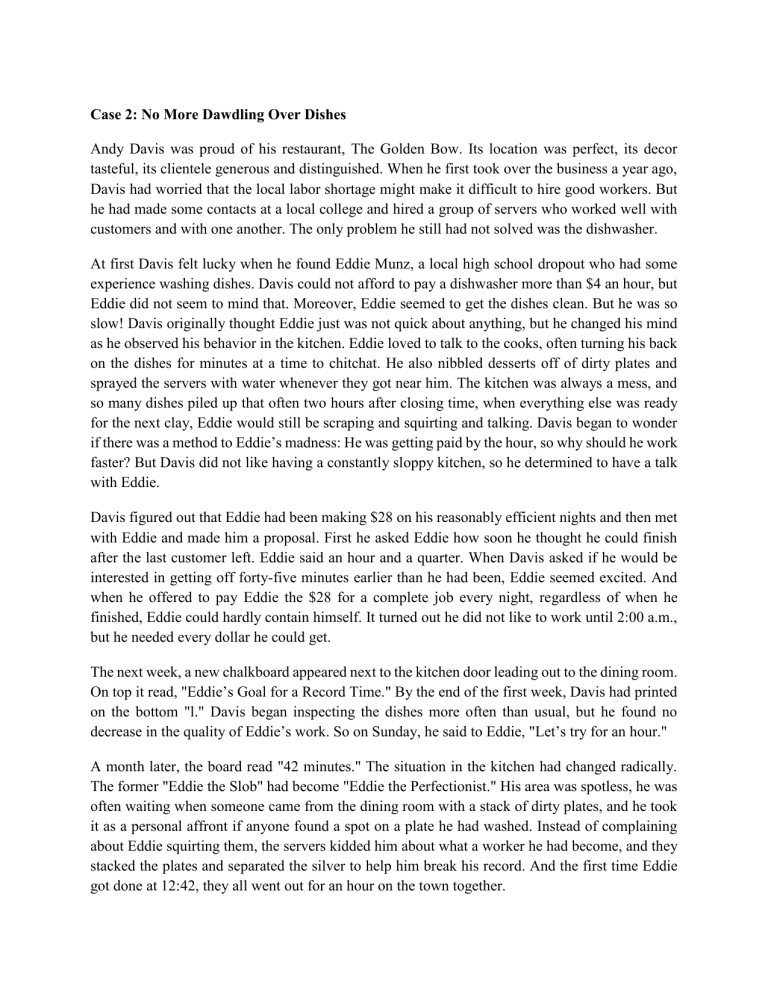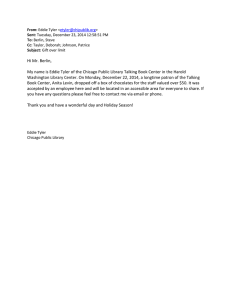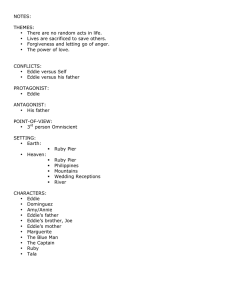
Case 2: No More Dawdling Over Dishes Andy Davis was proud of his restaurant, The Golden Bow. Its location was perfect, its decor tasteful, its clientele generous and distinguished. When he first took over the business a year ago, Davis had worried that the local labor shortage might make it difficult to hire good workers. But he had made some contacts at a local college and hired a group of servers who worked well with customers and with one another. The only problem he still had not solved was the dishwasher. At first Davis felt lucky when he found Eddie Munz, a local high school dropout who had some experience washing dishes. Davis could not afford to pay a dishwasher more than $4 an hour, but Eddie did not seem to mind that. Moreover, Eddie seemed to get the dishes clean. But he was so slow! Davis originally thought Eddie just was not quick about anything, but he changed his mind as he observed his behavior in the kitchen. Eddie loved to talk to the cooks, often turning his back on the dishes for minutes at a time to chitchat. He also nibbled desserts off of dirty plates and sprayed the servers with water whenever they got near him. The kitchen was always a mess, and so many dishes piled up that often two hours after closing time, when everything else was ready for the next clay, Eddie would still be scraping and squirting and talking. Davis began to wonder if there was a method to Eddie’s madness: He was getting paid by the hour, so why should he work faster? But Davis did not like having a constantly sloppy kitchen, so he determined to have a talk with Eddie. Davis figured out that Eddie had been making $28 on his reasonably efficient nights and then met with Eddie and made him a proposal. First he asked Eddie how soon he thought he could finish after the last customer left. Eddie said an hour and a quarter. When Davis asked if he would be interested in getting off forty-five minutes earlier than he had been, Eddie seemed excited. And when he offered to pay Eddie the $28 for a complete job every night, regardless of when he finished, Eddie could hardly contain himself. It turned out he did not like to work until 2:00 a.m., but he needed every dollar he could get. The next week, a new chalkboard appeared next to the kitchen door leading out to the dining room. On top it read, "Eddie’s Goal for a Record Time." By the end of the first week, Davis had printed on the bottom "l." Davis began inspecting the dishes more often than usual, but he found no decrease in the quality of Eddie’s work. So on Sunday, he said to Eddie, "Let’s try for an hour." A month later, the board read "42 minutes." The situation in the kitchen had changed radically. The former "Eddie the Slob" had become "Eddie the Perfectionist." His area was spotless, he was often waiting when someone came from the dining room with a stack of dirty plates, and he took it as a personal affront if anyone found a spot on a plate he had washed. Instead of complaining about Eddie squirting them, the servers kidded him about what a worker he had become, and they stacked the plates and separated the silver to help him break his record. And the first time Eddie got done at 12:42, they all went out for an hour on the town together. Case Questions 1- What did Andy Davis do to shape and change Eddie’s behavior? Andy Davis used a variety of strategies to shape and change Eddie Munz's behavior. First, he offered Eddie an incentive to work faster by offering to pay him a fixed amount for a complete job every night, regardless of when he finished. This reward was based on performance, as Eddie could only receive it if he completed the job faster than he had previously. Additionally, Davis set a goal for Eddie to strive for, by creating a chalkboard with "Eddie's Goal for a Record Time." This goal provided Eddie with a clear target to work towards and motivated him to improve his performance. Finally, Davis provided feedback and encouragement by inspecting the dishes more often and praising Eddie's improved performance. 2- Which motivational theories have been applied in this case? (at least two) In this case, two motivational theories that have been applied are goal-setting theory and reinforcement theory. Goal-setting theory posits that specific, challenging goals lead to higher levels of performance, and that feedback and reinforcement can help individuals stay motivated and track progress towards those goals. Reinforcement theory suggests that behavior that is followed by positive consequences (reinforcements) is more likely to be repeated, while behavior that is followed by negative consequences (punishers) is less likely to be repeated. In this case, Davis used goal-setting and reinforcement to motivate Eddie to work faster and improve his performance. 3- If you were the Davis what rewards would you used to get the same results from Eddie Munz? If I were Andy Davis, I would consider using a variety of rewards to get the same results from Eddie Munz. Some options might include: Additional pay: Davis could offer to increase Eddie's hourly wage or provide bonuses based on his performance. This would provide an economic incentive for Eddie to work faster and improve his performance. Time off: Davis could offer Eddie additional time off or flexible scheduling as a reward for meeting his performance goals. This could be particularly motivating for Eddie, as he mentioned that he did not like working late into the night. Recognition: Davis could recognize and praise Eddie's improved performance in front of his colleagues or other team members. This could be a powerful motivator, as it would help Eddie feel valued and appreciated for his contributions. Professional development opportunities: Davis could offer Eddie the chance to participate in training or professional development opportunities as a reward for meeting his performance goals. This could help Eddie develop new skills and knowledge that could benefit him in his career. Non-financial rewards: Davis could also consider using non-financial rewards to motivate Eddie, such as gift cards, merchandise, or other types of recognition. These types of rewards could be particularly effective if they align with Eddie's interests or values. Case-4: A SOLUTION TO GROWING PAINS In 2015, Aytekin Tank was the CEO of Jotform, a global company that specializes in online formbuilding tools. After a decade of building his startup, the company was expanding rapidly and doing well, in part to Tank’s commitment to hiring talent. Despite a commitment to hiring top talent and fostering a supportive and innovative work culture, this growth came at a cost. Tank could see his company losing momentum, and the young entrepreneur could not put his finger on why. When Jotform began to grow, the CEO explored ways to recapture the advantages of having a smaller team. “I looked back to the time when we had around five people. I tried to figure out what had changed: why we moved so fast when we were five people, why we felt like a family when we were that small.” The solution, Tank found, was to restructure his organization into cross-functional teams. This approach was pioneered in the twenty-first century by Jack Welch (shown here), CEO of General Electric (GE), who believed dividing employees by function led to slower and poorer decisions. Welch’s cross-functional or boundaryless organization created forums where employees with different roles within the company could meet and coordinate decision making. Welch found that GE became more efficient when employees from marketing, finance, engineering, and many other sectors had a chance to work together. It has been over twenty years since Welch popularized cross-functional teams, and many organizations have found that adopting a cross-functional structure gives them a competitive edge over more traditional company. Tank found that, by dividing his company into cross-functional teams, he was able to re-create the close-knit, efficient structure of the smaller organization that Jotform used to be. In this new structure, team members came from several different parts of the organization, allowing for better communication across different functions. Teams typically had a web designer, a programmer, and a marketing analyst (or similar position), all working on solutions to organizational problems. Once these teams were formed, Tank also made sure that each team had their own meeting space and a budget for fun activities like weekly lunches. Besides building morale, the Jotform leader believed that cross-functional teams allowed team members to bond and ultimately begin to trust each other. His goal was to breed cooperation rather than competition. Tank also made sure to keep Jotform’s teams small, allowing employees to feel greater ownership over their successes and failures. By having team members from several different functions, employees could see how their work affected other parts of Jotform for better—or worse. The last ingredient in Tank’s cross- functional teams was autonomy—freedom to make decisions that have an impact on other parts of the organization, tackle problems the way they want, and work the way they want. Tank’s decision has given his company the same edge it did when it was smaller. After restructuring the company, Jotform experienced increased productivity. By mixing different functions of the company into teams, employees could make decisions more quickly. Teams had more diverse skill sets, so they were able to tackle any problems the company faced with greater creativity by using varied perspectives from different parts of the company. Even though the move was successful, Tank admits that he was afraid of trying something new in the beginning. Still, he realizes that in order to continue to grow the company, he had to take a risk. “Change can be difficult for people and for companies,” Tank has said when discussing the move to crossfunctional teams. “However, if your current system is not effective and you don’t take the initiative to improve via change, staying the course can be disastrous.” Case Questions 1- highlight the advantages and disadvantages of cross-functional teams from this case. Some advantages of cross-functional teams highlighted in this case include increased productivity, better communication across different functions, the ability to tackle problems with greater creativity and diverse skill sets, and increased morale and trust within the team. However, implementing this structure may also pose challenges, such as the potential for conflicts between team members with different functions and the need for effective communication and coordination among team members with diverse backgrounds. 2- If Tank were to call you in as a consultant, which type of team (apart from crossfunctional) would you suggest him to build. If Tank were to call you in as a consultant, one type of team you might suggest for JotForm is a self-managed team. A self-managed team is a group of employees who are given the autonomy and responsibility to manage their own work and make decisions without the need for direct supervision. This structure can be effective in promoting innovation and ownership among team members, as well as increasing efficiency and agility. However, implementing self-managed teams requires a high level of trust, commitment, and accountability from team members, and may not be suitable for all organizations or situations. It would be important to carefully assess the readiness and suitability of JotForm’s employees and culture for this type of structure, as well as the specific goals and needs of the organization. 3- Suppose Tank has some members who are not team players. Suggest him how can he turn them into team players? Suppose Tank has some members who are not team players. Suggest him how can he turn them into team players? There are a few strategies that Tank could consider to help turn non-team players into team players: Clarify the team's goals and objectives: By clearly communicating the team's goals and objectives, Tank can help non-team players understand the purpose and importance of their work within the larger context of the organization. This can help motivate them to contribute to the team's success. Encourage open communication and collaboration: By fostering a culture of open communication and collaboration, Tank can create an environment where non-team players feel comfortable sharing their ideas and concerns. This can help them feel more invested in the team's work and more willing to contribute to its success. Provide support and resources: By providing non-team players with the necessary support and resources, Tank can help them feel more equipped to contribute to the team. This might include providing training, coaching, or access to necessary tools and technologies. Foster a sense of belonging: By creating a sense of belonging within the team, Tank can help non-team players feel more connected to their colleagues and the organization. This might involve building team cohesion through activities such as team building exercises or social events. Recognize and reward team contributions: By recognizing and rewarding team members for their contributions, Tank can help non-team players feel valued and motivated to continue contributing to the team's success. This might involve providing praise, recognition, or rewards for team achievements. Case 6- College Corp. Janice just graduated college, she’s ready to head out on her own and get that first job, and she’s through her first interviews. She receives an offer of a $28,000 salary, including benefits from COLLEGE CORP, from an entry-level marketing position that seems like a perfect fit. She is thrown off by the salary they are offering and knows that it is lower than what she was hoping for. Instead of panicking, she takes the advice of her mentor and does a little research to know what the market range for the salary is for her area. She feels better after doing this, knowing that she was correct and the offer is low compared to the market rate. After understanding more about the offer and the rates, she goes back to the HR representative and asks for her preferred rate of $32,500, knowing the minimum that she would accept is $30,000. Instead of going in for her lowest amount, she started higher to be open to negotiations with the company. She also sent a note regarding her expertise that warranted why she asked for that salary. To her happy surprise, the company counter offered at $31,000—and she accepted. Questions: 1- What key points of Janice’s negotiation led to her success? Some key points of Janice's negotiation that led to her success include: Doing research to understand the market rate for the position and her preferred salary range Asking for a salary higher than her minimum acceptable amount, allowing room for negotiation Supporting her request with examples of her expertise and value to the company Being open to a counteroffer and considering it carefully 2- What could have Janice done better to get a better outcome for her salary? Some additional strategies that Janice could have used to potentially improve the outcome of her salary negotiation include: Identifying the interests and needs of the company, and explaining how her skills and experience can meet those needs Offering specific examples of her accomplishments and achievements that demonstrate her value to the company Seeking advice or coaching from experienced colleagues or mentors to help her prepare for the negotiation Being assertive and confident in communicating her value and worth to the company 3. Could a leadership training program be set up to help Rohail? What would it consist of? A leadership training program for Rohail could consist of a variety of activities and interventions designed to help him develop the skills and abilities needed to be an effective leader. This could include: Training in communication and interpersonal skills, such as listening, empathy, and conflict resolution Development of problem-solving and decision-making skills Coaching on how to build and manage teams effectively Opportunities to practice and apply leadership skills through role-playing or real-world projects Feedback and guidance from experienced leaders or mentors to help Rohail identify areas for improvement and support his development. Case Study-8 The management team at Learner’s Edge, an online continuing education company, decided to adopt a ROWE (results-only work environment) policy, developed by Best Buy employees and summarized in its slogan, “Work whenever you want, wherever you want, as long as the work gets done.” Kyle Pederson was one of only three Learner’s Edge employees who showed up the first day of the ROWE experiment. And the second day, and the third. “For almost a month, everyone cleared out,” Pederson said. “It was just me, my co-founder and our executive director all wondering, ‘What on earth have we done?’ ” Clearly, employees were testing the outer limits of workplace flexibility. Thankfully, it paid off. Learner’s Edge reported “better work, higher productivity” after the initial phase of the program. It seems employees knew the ways they work best. In fact, some of Pederson’s employees have returned to the office, while others gather at Starbucks or over dinner . . . whatever gets the work done. Suntell president and COO, Veronica Wooten, whose risk-management software firm adopted the ROWE program a few years ago, is also a fan of the flexible workplace. “We made the transition, and started letting go and letting people make their own decisions,” Wooten said. As a result of workplace flexibility, the company’s customer base increased 20 percent, meetings were reduced by 50 percent, and expenses decreased 12 percent (Wooten used the savings to give everyone a raise). It seems that everyone should be happy with this ultimate degree of job flexibility. Employees worldwide do seem to increasingly value flexible work environments, with roughly two of three workers of all ages wanting to work from home, at least occasionally. However, the benefit may not be as great for some people. In a recent study, 62 percent of respondents believed that Gen X individuals benefit most from flexibility arrangements, 35 percent believed Gen Y individuals benefit most, and only 3 percent believed baby boomers benefit most. Research correlates job satisfaction most strongly with the nature of the work itself, not the location where it is performed. Thus, while as employees we say we want flexibility, what actually makes us satisfied is often something else. Then there are the costs of such work arrangements. Employers such as Yahoo!’s Marissa Mayer have thought that flexible workers become detached from the organization, communicate less, are less available, and lose the benefits of teamwork. Employees have concerns about long periods of working away from the office: Will out of sight mean out of mind to their employers? For ROWE or any flexible arrangement to work, organizations need to create clear job descriptions, set attainable goals, and rely on strong metrics to indicate productivity. Managers need to foster close connections and communicate meaningfully to keep flexible workers engaged in the company, its culture, and its processes. Most importantly, employees need to get the work done, no matter where and when they do it. Questions” 1. Do you think only certain individuals are attracted to flexible work arrangements? Why or why not? It is possible that certain individuals may be more attracted to flexible work arrangements, such as those who value work-life balance or those who prefer to work independently. However, it is important to note that the benefits of flexible work arrangements may vary depending on the individual and their specific needs and preferences. Some individuals may thrive in a flexible work environment, while others may prefer more structure and support. 2. Which industries and types of businesses can easily implement the concept of flexible working and where do you think it is difficult to implement? Flexible work arrangements may be easier to implement in industries or businesses that involve primarily independent or self-directed work, such as consulting or freelance work. It may be more difficult to implement flexible work arrangements in industries or businesses that require close collaboration and teamwork, or that have strict schedules or deadlines. 3. How might flexible work place more pressure on managers to organize their employees? Flexible work arrangements may place more pressure on managers to organize their employees effectively, as they may need to ensure that work is being completed effectively and efficiently without the benefit of being able to closely supervise or monitor employees in person. This may involve setting clear goals and expectations, using strong metrics to measure productivity, and fostering close connections with employees to ensure they remain engaged and motivated. 4. How might flexible work affect a company’s bottom line? Flexible work arrangements can potentially affect a company's bottom line in a number of ways. On the one hand, flexible work arrangements may increase productivity and employee satisfaction, which could lead to increased profits and a positive impact on the company's bottom line. On the other hand, there may be costs associated with implementing flexible work arrangements, such as the need to provide employees with the necessary technology and equipment to work remotely. Additionally, there may be challenges in managing and organizing a flexible workforce, which could impact the company's efficiency and profitability. Overall, the impact of flexible work arrangements on a company's bottom line may depend on a variety of factors, including the specific industry, the size and structure of the company, and the individual needs and preferences of employees. CASE 10: HUMAN RELATIONS AT SONY In his biography, Made in Japan, Morita says: The most important mission for a Japanese manager is to develop a healthy relationship with his employees, to create a family-like feeling within the corporation, a feeling that employees and managers share the same fate. Those companies that are most successful in Japan are those that have managed to create a shared sense of fate among all employees, what Americans call labor management. When Morita was chairman of Sony, he stressed to new employees that each employee had to seek happiness in his or her work and to decide personally whether to spend the rest of his or her working life at Sony. At Sony, there are few noticeable differences between management and labor. Although management writers sometimes paint a too-rosy picture of Japanese management-labor relations, Sony's management philosophy is that employees should be treated as colleagues and helpers, not merely as means to profits. Investors are important, Morita acknowledges, but they establish only a temporary relationship with the company. Employees are more important because they are a permanent part of the company, just as much as top management. In return for showing loyalty to employees, Morita expected loyalty from his employees, But he urged them not only to use their best efforts on the company's behalf but also to question management views. Ironically, Morita's emphasis on loyalty was partly inspired by his experience with American managers and employees. In its early days, Sony hired many employees in the United States in an effort to keep pace with the remarkable demand for its products. Morita was stunned by an American colleague's blunt advice about a problem employee: "Fire him." Morita was equally surprised when an American employee walked into his office one day and announced he was quitting to take a job with a competitor; who had offered him double his salary. Under Morita, the whole process of recruiting, selecting. training, and appraising employees was built on the premise that employees are the most valuable part of the company. Granted, Morita's policies—especially the idea of lifetime job security are some of the typical characteristics of Japanese companies which differentiated them from others. PEOPLE AS RESOURCES Sony has long been a leader in human resources Management in Japan. The company has adopted such American concepts as the five-day, 40-hour work week, even though Japanese law still sanctions a maximum of 48 hours, and the average in Japanese manufacturing remains 43 hours per week. Moreover, Sony was one of the first Japanese firms to close its factories for one week every summer to allow all its employees to be off work at the same time. In addition, the Japanese system enforces a different view of recruits. Morita urges managers to see recruits as rough stones and the managerial job as the task of building a strong and sturdy wall out of these rough stones. The Japanese ideal is to shape and smooth managerial recruits so that they become a cohesive part of the company. Japanese companies, at least the large ones, also have a humane attitude toward dealing with employees. In declining industries, most companies offer retraining and most workers eagerly accept it. At Sony; workers are retrained when their particular jobs become obsolete. Clearly, Akio Monta's motivational policies accommodate Sony's overall strategy. By focusing on the shared fate of management and employees, Sony develops among its workers a sense of commitment towards the attainment of the overall goals of the firm. Partly because of this employee commitment, Sony has been able to stay competitive in terms of wages and benefits and to motivate highly competent people to continue to innovate. By focusing on people as resources rather than as costs, companies like Sony are writing the book on future management theory and practice. On-Site for Dining For the Sony Family Sometimes human resource management can involve something as seemingly unrelated as providing an on-site corporate dining facility. As more and more companies consolidate their urban offices into single, low-rent, sub-urban developments, the benefits of on-site dining are becoming increasingly apparent. At Sony, on-site dining perceive as more than merely a pleasant eating experience. “When employees eat in, they tend to exchange work ideas,” explained Sony’s Gordon Casanova, director of facilities management, corporate services. “They continue the workday on a different level.” On-site dining has allowed Sony to confine lunch breaks to 45 minutes, since it eliminates the need for commuting lunch. Moreover, added Casanova, On-site dining sharply curtails lunch hour abuses.” In addition, on-site dining brings employees together in a more relaxed setting, outside the work environment so that they can have the opportunity to bond socially. This, in turn, can ease work relationships and enhance productivity. Also, the on-site dining encourages intra-company networking by bringing together people of different positions from different departments. Such networking can ultimately facilitate internal communication by giving people faces to attach to the names with whom they work. At Sony, on-site dining also helps to break down barriers between management and staff. “I have always made it a point to know our employees, to visit every facility of our company, and to try to meet and know every single employee,” said Morita. “This became more and more difficult as we grew, and it is impossible to really know the more than forty thousand people who work for us today, but I try. I encourage all of our managers to know everybody and not to sit behind a desk in the office all day.” The dining facility thus helps to strengthen work-related relationships. According to Morita, a company is a sort of family. When he was CEO, he considered socializing with employees an integral part of his day. “It was not just part of my job, I like those people. They are family...” By providing in-house dining, Sony was able to increase employee productivity and morale and promote its family oriented culture. “We have a policy that here we are in the world we deal with our employees as members of the Sony family, as valued colleagues,” explained Morita. “We brought management people, including engineers, to Tokyo and let them work with us and trained them and treated them just like members of our family, all of whom wear the same jackets and eat in our one-class cafeteria. This way they got to understand that people should not be treated differently…We urged the management staff to sit down with their office people and share the facilities.” For Morita, it is not human resource management; it is respect for one’s family. Indeed, Morita's ideas are the basis for what management writer Tom Peters proposes as a new, more realistic pact between employer and employee: Employees will commit themselves to doing their best to help the company meet its goals, and in return, the company will give employees an opportunity to develop and hone their skills. Of course, they are free to leave and sell these skills to another employer but ideally, the opportunity to keep learning and to do good work will keep them with the company and-increase both their loyalty and their productivity. QUESTIONS: Compare and contrast the Motivational philosophy of both American and Japanese firms in the light of the case study? Marks 2 and maximum allowed word limit is 100. American firms tend to focus more on individual achievement and rewards, such as financial incentives, while Japanese firms tend to place a greater emphasis on group harmony and a sense of shared fate. Sony, as a Japanese firm, follows this approach and emphasizes the importance of creating a strong sense of commitment and loyalty among employees, as well as treating them as colleagues and partners. Which motivation theories are applied or can be applied in the light of the working of Sony Company? Support your answer with arguments? Marks 5 and maximum allowed word limit is 200. Some of the motivation theories that could be applied to the working of Sony include Maslow's Hierarchy of Needs, which emphasizes the importance of meeting basic physiological and safety needs before addressing higher level needs such as self-esteem and self-actualization. Another theory that could be applied is the Two-Factor Theory of Motivation, which suggests that motivation is influenced by both hygiene factors (such as working conditions and pay) and motivators (such as achievement and recognition). Sony's emphasis on training and development, as well as its focus on creating a positive and supportive work environment, aligns with these theories. Which OB related behaviors can be seen or observed in the working of Sony? Marks-3 and allowed maximum word limit is 100 words. Please mention only in bullet points. Some OB-related behaviors that can be observed in the working of Sony include: •A focus on creating a sense of shared fate and group harmony among employees •A commitment to treating employees as colleagues and partners, rather than just means to profits •An emphasis on training and development, as well as a positive and supportive work environment •A focus on meeting the needs of employees, including basic physiological and safety needs, as well as higher level needs such as self-esteem and self-actualization •A commitment to retraining and supporting employees in declining industries






